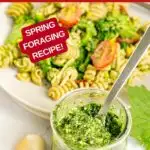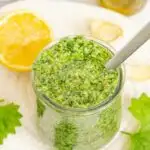Imagine if pesto and chimichurri sauce had a baby... a delicious sauce baby. That's what this Garlic Mustard Pesto tastes like! This sauce is bold, flavorful, fragrant, and garlicky.
It's that time of the year where garlic mustard is overgrowing EVERYWHERE, and this is a great recipe to use up lots of garlic mustard at once. If you're a fan of bold, flavorful sauces, you're going to love this unique pesto recipe. Make sure to read below for lots of ways to use garlic mustard pesto. And be sure to check out this sour sorrel pesto recipe too.

Jump to:
What is garlic mustard?
If you're not familiar with garlic mustard, it is not garlic and it is not mustard. It is a plant that grows in many parts of the US. In my area, it is pretty invasive and destructive, so the advice I hear from all local naturalists is "eat it to beat it."
WELL OKAY, I CAN DO THAT!
And you can help too! Picking garlic mustard is a great way to clear up your yard, or help a friend with their yard and share some homemade pesto with them. 🙂
Pesto is by far the most delicious way to eat garlic mustard.
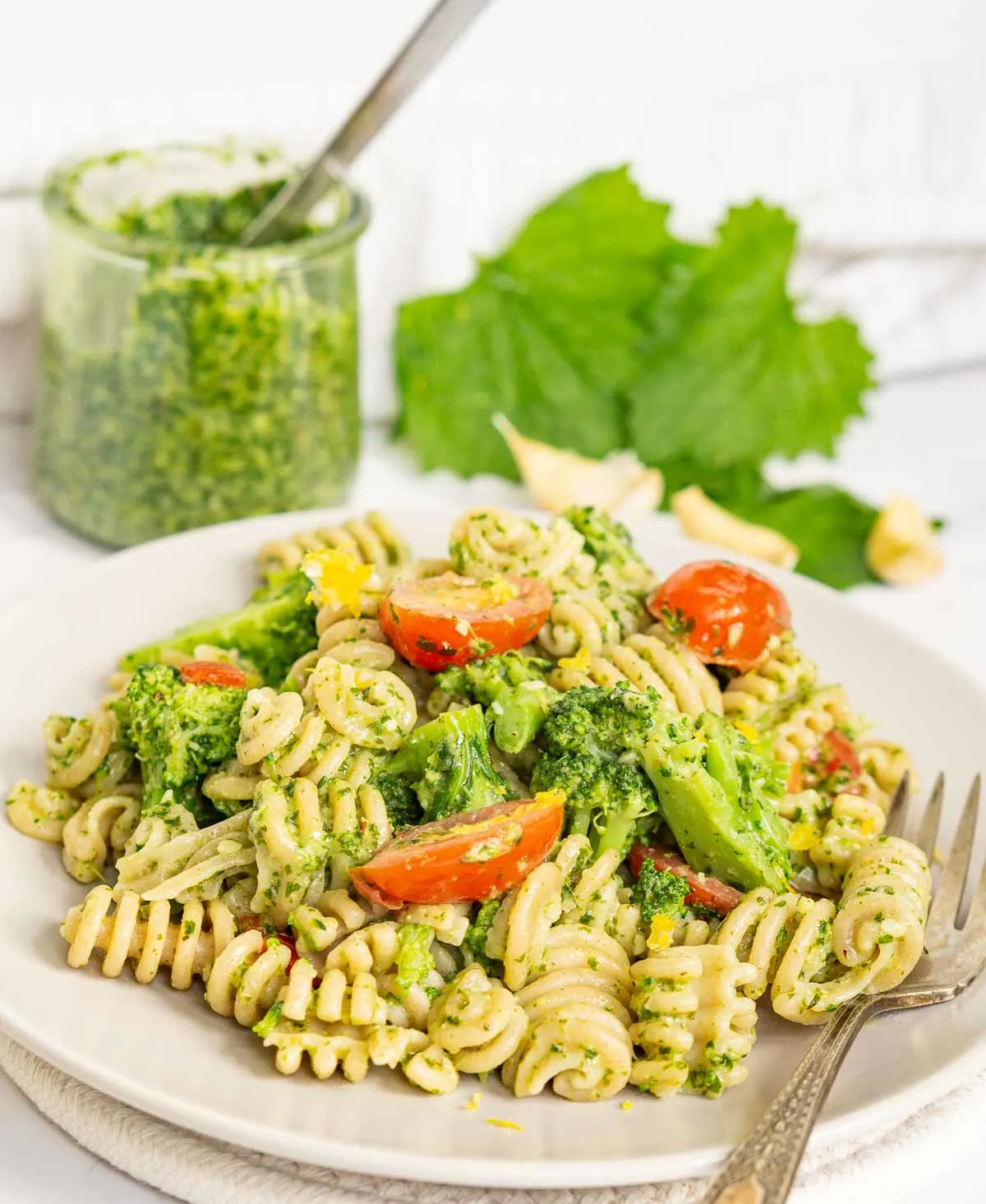
More foraging recipes: Pickled Fiddleheads
What does garlic mustard pesto taste like?
Garlic mustard pesto is not as mild-tasting as basil pesto. Garlic mustard itself is a little peppery, raddish-y, and spicy, so the pesto you get from garlic mustard leaves is also a bit peppery, raddish-y, and spicy. 🙂
It's like if pesto and chimichurri had a delicious sauce baby.
If you like peppery arugula and enjoy adding garlic mustard leaves to your salad, then you'll love garlic mustard pesto!
More foraging recipes: Mulberry Ice Cream
*Necessary disclaimers*
Before I tell you to go pick a ton of garlic mustard, I have to add all the usual advice: only pick and eat leaves from plants you can identify 100% correctly, do NOT eat anything you're unsure about. Only pick garlic mustard in places where it's legal to do so (so probably not in public parks or state forests or on private property without permission). Check with your doctor about eating anything you pick to make sure it won't interfere with any medicines you take and to make sure it is fine for your health, do not eat foraged foods when pregnant or feed them to kids, and wash all the foraged foods well before eating them or cooking with them because of dust, dirt, animals in the woods, etc. Forage responsibly to not harm nature. Phew. I think that covers it?
More foraging recipes: Mulberry Syrup
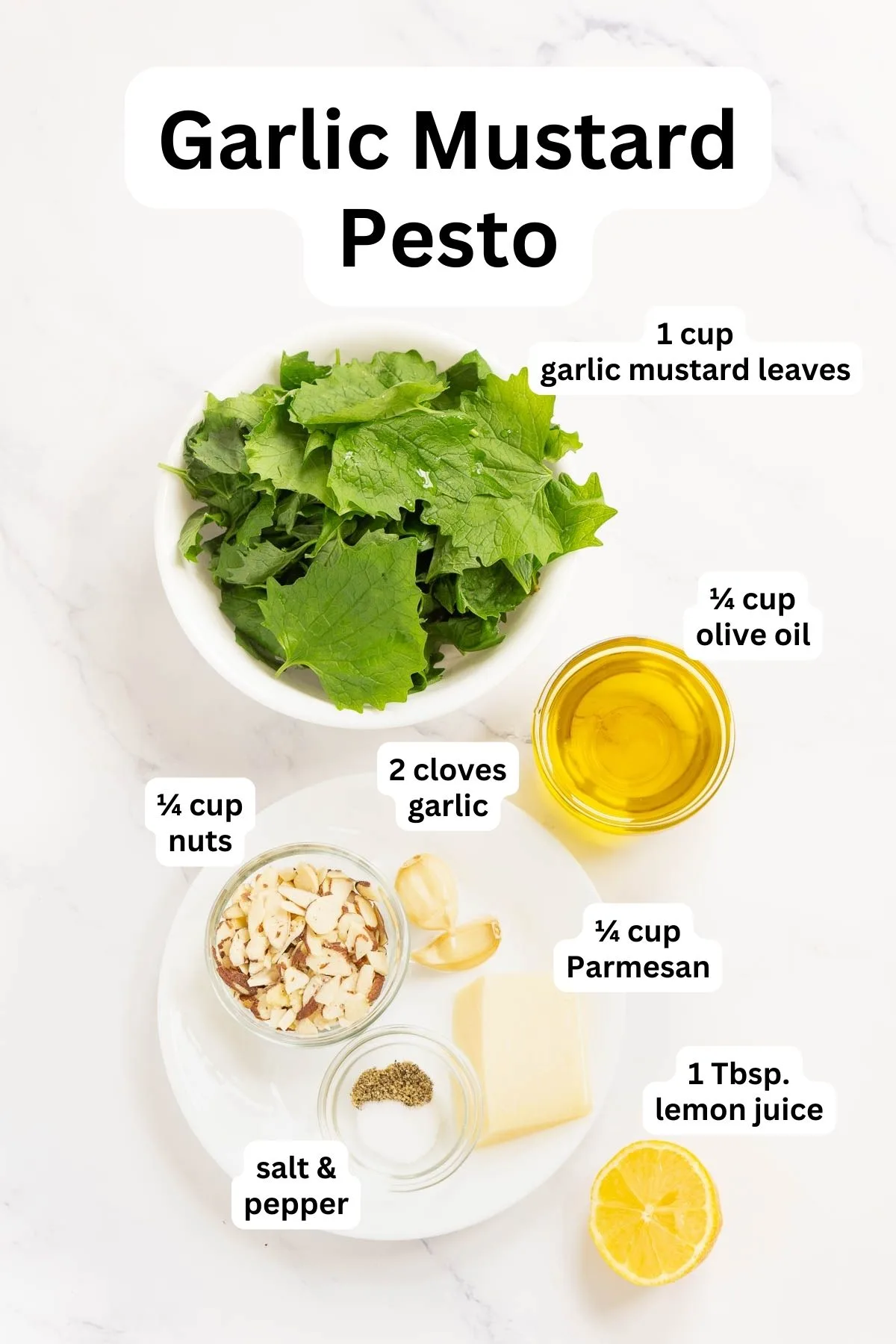
Ingredients
- 1 cup garlic mustard leaves, tightly packed. Make sure you thoroughly wash the leaves and dry them as much as possible, either with a paper towel, by letting them air dry, or using a salad spinner. If you want to throw in some ramps (wild leeks) or fresh basil to cut down on the spicy mustardy flavor, go right ahead! Just have about 1-1.25 cups of leaves total.
- ¼ cup slivered almonds, or nuts of your choice. Pine nuts are traditionally used in pesto but they're crazy expensive. I used slivered almonds, but you can use walnuts, pistachios, or whole almonds if you like. Just make sure that your nuts are toasted and have no salt added, otherwise reduce the salt. For a nut-free pesto, use unsalted roasted sunflower seeds, or skip the nuts.
- ¼ cup cubed parmesan cheese. You can also use grated Parmesan cheese, but I like starting off with the cubes to give the pesto a little extra crunchy texture.
- ¼ cup olive oil. I sometimes add a few extra tablespoons at a time towards the end, depending on how thick or thin I want this pesto to be.
- 2 cloves garlic
- 1 tablespoon lemon juice (½ of a small lemon). Optional, and not a traditional pesto ingredient, but I highly recommend making your pesto lemony! It's so good! Fresh squeezed lemon juice is best!! Don't use the bottled stuff.
- ¼ teaspoon each salt and pepper. Start with ¼ teaspoon, and then add more to taste at the end, if needed.
Related recipe: Garlic Scape Butter
Equipment
- Small food processor. I have this 3-cup one and love it for pesto!
- Lemon juicer or squeezer. Either one works great for squeezing a half of a lemon.
- Measuring cups and spoons
Instructions
Place all the ingredients in a small food processor and process until the pesto is smooth enough for your liking. You will need to stop a few times and scrape the sides down. Once blended to your liking, give it a taste and see if you want to add more salt, pepper, or olive oil.
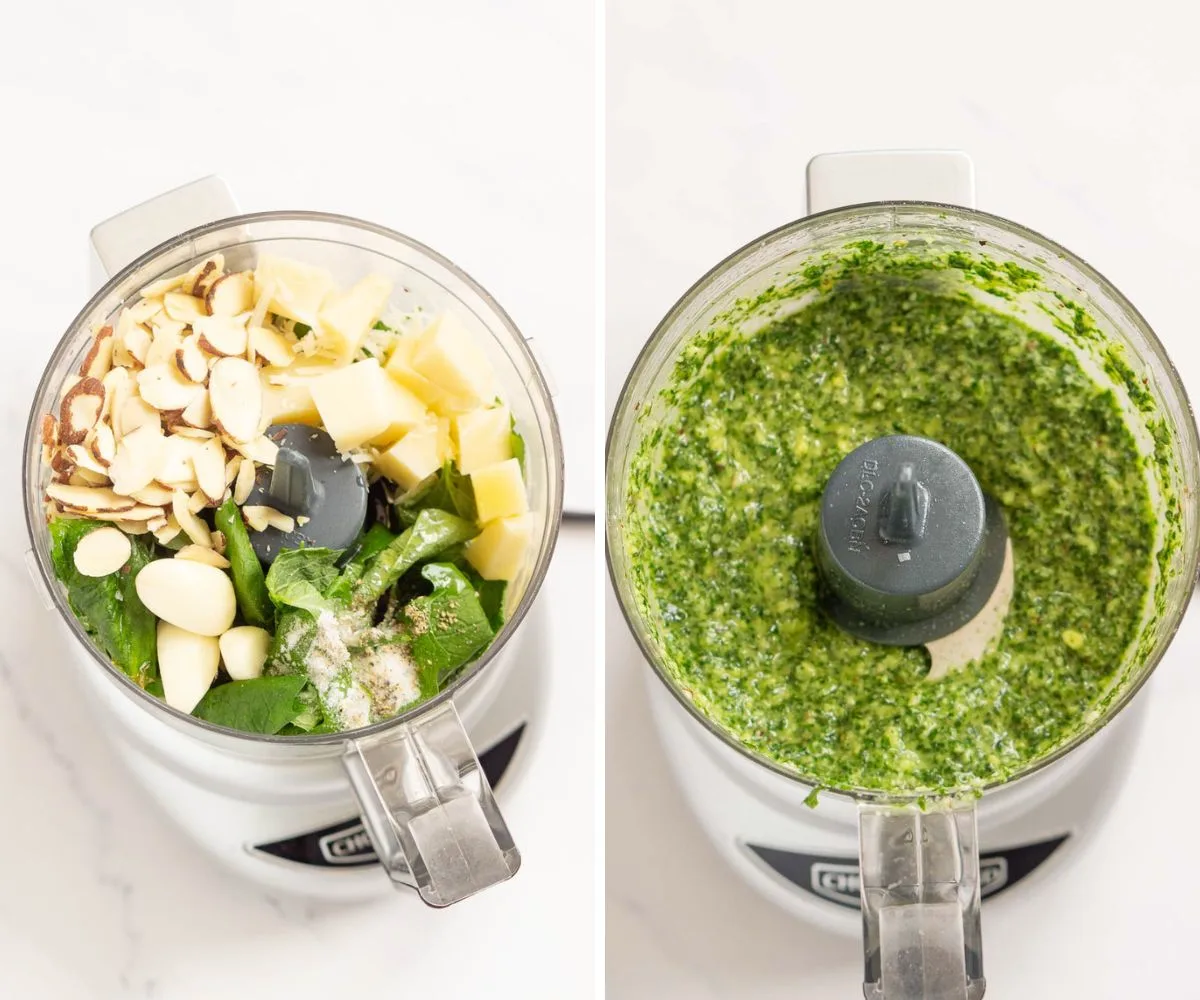
Store in a sealed jar in the fridge for up to 1 week.
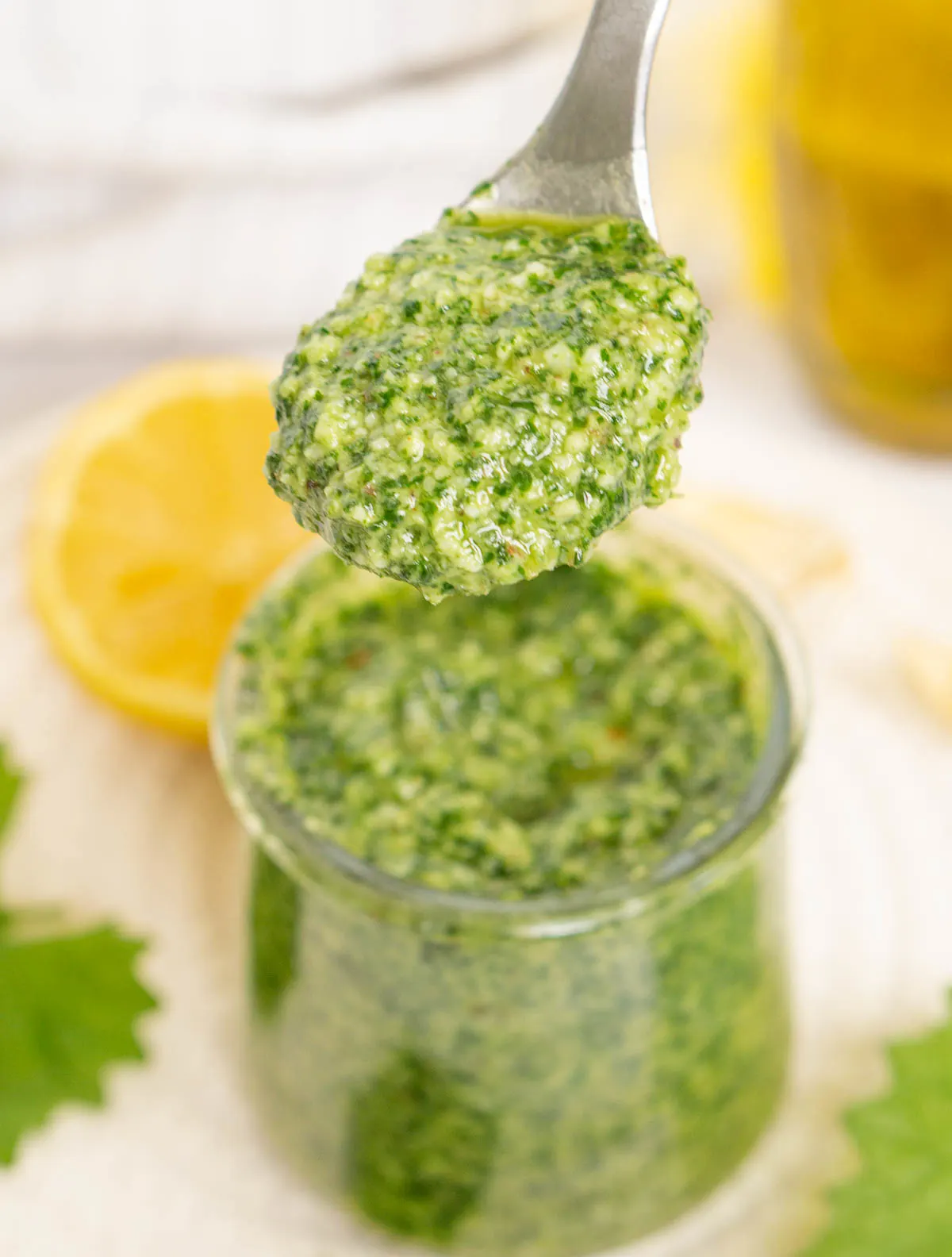
Related recipe: Pickled Garlic Scapes
How to serve garlic mustard pesto
Serve this pesto as you would any other pesto, but keep in mind it's a little bit spicier and bolder than traditional pesto. It works great in:
- In pasta (this would be FANTASTIC in many of these spring pasta dishes!)
- As a spread in sandwiches or in cottage cheese toast or burrata toast
- As a dip for a baguette
- Over grilled chicken or salmon
- On steak instead of chimichurri sauce
- Tossed with roasted young potatoes or roasted cauliflower
- For this pesto crostini with roasted tomatoes
- As a sauce for this pesto pizza. I recommend doubling the recipe in this case, so you can have some pesto left over for other uses.
- Use leftover pesto to make this pesto butter. It is so so so good!!
- As a condiment with scrambled eggs
This pesto made it on my list of spring appetizers, so be sure to check those out too!
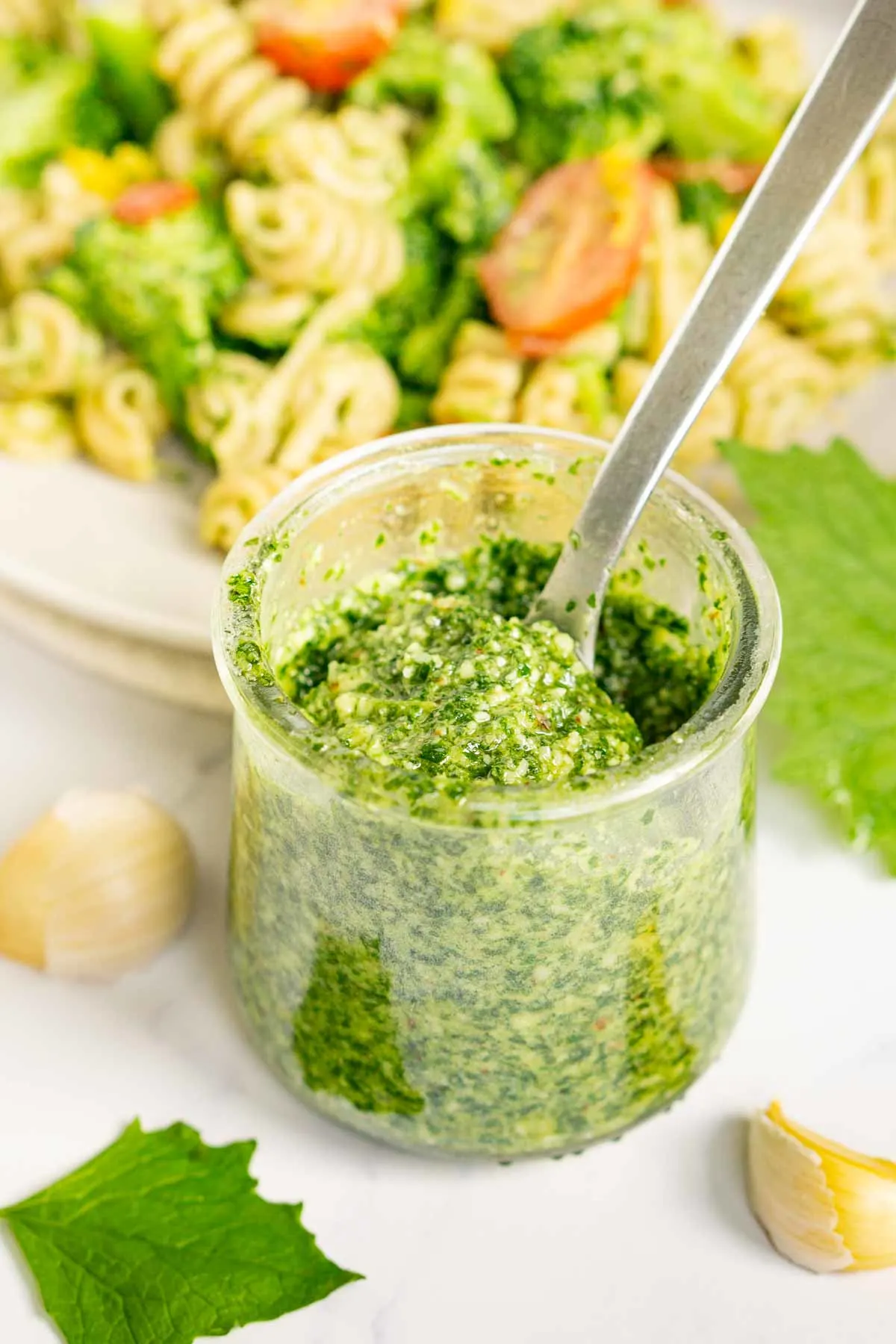
How long will garlic mustard pesto keep?
Garlic mustard pesto will keep in the fridge for up to 1 week, or will stay fresh while frozen for up to a month or two.
More foraging recipes to try: Air Fried Chicken of the Woods Mushroom
How to freeze garlic mustard pesto
I love freezing pesto in ice cube trays so I can easily thaw only as much as I need to use. After the pesto is frozen in the ice cream trays, pop the cubes out and place in the zip lock back in the freezer. The only annoying part is washing out the oily ice cube tray after the pesto cubes!
If you enjoyed this recipe, let me know with a comment and a star rating below. And don't forget to share it on Facebook and save it on Pinterest for later!
Garlic Mustard Pesto
Ingredients
- 1 cup garlic mustard leaves - tightly packed, thoroughly washed and dried so they're not dripping wet.
- ¼ cup slivered almonds - or any nuts, see notes
- ¼ cup parmesan cheese - (2 oz block, cut into ½-inch cubes)
- ¼ cup olive oil
- 2 cloves garlic
- 1 tablespoon lemon juice - (½ of a small lemon)
- ¼ teaspoon salt - or more to taste
- ¼ teaspoon ground black pepper - or more to taste
Special equipment
Instructions
- Place all the ingredients in a small food processor and process until the pesto is smooth enough for your liking. You will need to stop a few times and scrape the sides down. Once blended, give it a taste and see if you want to add more salt, pepper, or olive oil.
- Store in a sealed jar in the fridge for up to 1 week.
- If you liked this recipe, don't forget to give it a star rating and pin it on Pinterest!
Notes
Nutrition
The nutritional information displayed is an estimate and not to be used as dietary or nutritional advice. Consult a nutritionist or dietician for nutritional info based on the exact ingredients you use.

